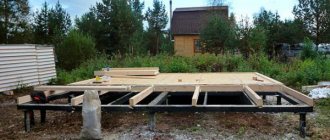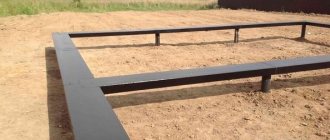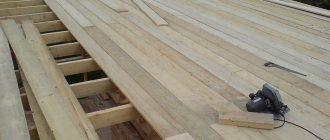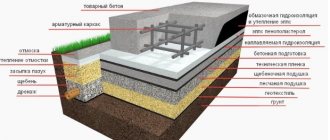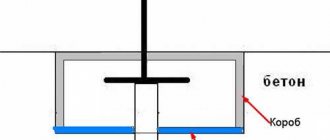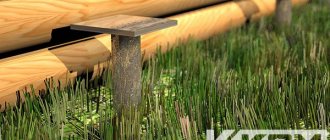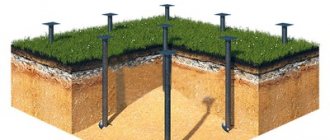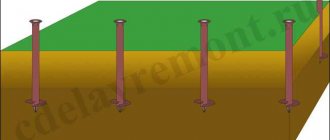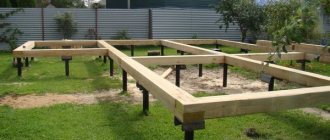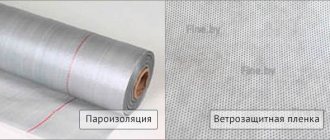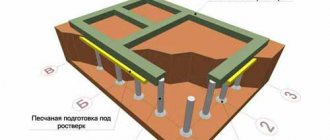Design and types of pile drivers, operating technology
Machines for driving piles have different dimensions for different lengths of piles and their depth. Accordingly, they have different power and functional features. They also differ in the drive of the driving apparatus.
The pile-driving installation itself can be located on the basis of several types of machines, it can be removable or not.
Pile driving methods
The pile drivers lift the pile, with the help of 1-2 people and sometimes special equipment - a bulldozer, install it in the desired design position and the driving process begins, in which 3 main technologies are used:
- Impact method
, in which pile driving occurs under periodic (20-40 per minute) blows of a pile driver hammer.
Driving a pile with a diesel hammer
Before driving a pile, a special tip is put on it, which prevents the destruction of the pile under the influence of hammer blows.
- Vibration method
, in which piles are immersed in the ground due to vibrations. In general, these are the same blows, only at a low frequency.
I recommend: How to install a flat roof
- Pressing in piles
. A modern method of installing piles, providing high speed and virtually silent operation without vibrations compared to the driving method. Pressing is carried out by pile pressing machines using their own weight and additional loads.
Unstressed methods
Impact-free methods are based on achieving soil softening, using a special design of supports, or simplifying the driving of piles. These methods can significantly simplify labor costs for immersing foundation supports by an average of 20-40%.
Screwing method
Screwing technology is used to deepen screw piles. Their blade design allows, when imparting torque, to deepen pile supports into the ground even without the use of special equipment and tractors.
Watch a video about how the support is installed by screwing it into the ground.
The method is used in cases where it is necessary to erect a low-rise building, masts, power lines and other structures in conditions of loose or flooded soils. The technology is relatively simple and can be used in any climate.
Screw piles are usually made of steel or reinforced concrete. The lower part is widened due to the installed blades, which gives the screwed support additional resistance to shear and pull-out forces. Piles can be screwed in without problems even in densely built-up conditions, without worrying about possible subsidence of the soil under the constructed objects.
Soil washing method
Installation of piles using the soil washing method is used to deepen supports in loose and loose layers. The greatest efficiency is achieved when it is necessary to drive pile structures with a large diameter and/or length.
Soil washing scheme
The technology consists of eroding the soil under high pressure of water supplied through pipes with a diameter of 38-62 mm in the direction of deepening the pile. The density of the soil is reduced due to loosening and washing out, and the water rising to the surface erodes the walls and reduces the lateral friction of the submerged structure on the passable soil layers. The path of the pile is cleared under its own weight, and the soil is washed out to the surface.
The water supply pipes may be located on the side or in the center of the pile. The lateral water jet is the most advantageous, as it can significantly facilitate the deepening process by reducing the influence of lateral friction. The tubes are fastened so that their ends are 300-400 mm above the tip of the pile supports. The minimum water pressure is 500 kPa.
During water supply, the bearing capacity of the dense layer may deteriorate, so soil erosion is stopped 50-200 cm before reaching the specified design depth.
Electroosmosis method
The technology for installing piles using the electroosmosis method is based on immersing two piles, connecting one to the negative pole of the electrical network, and the second to the positive pole. As a result of this connection, moisture begins to accumulate near the negatively charged support, making it easier for it to sink. Additionally, a driving installation can be used to speed up penetration.
After turning off the current, the bearing capacity of the soil is completely restored. The humidity level returns to its previous state.
Indentation method
The technology of pressing piles is effectively used for supports of short length from 3 to 5 m and with a tubular cross-section. Pile driving is carried out by applying a static load.
Watch the video to see how the process of pressing in reinforced concrete supports takes place.
First, the support is installed in the desired position, the head is fixed to the upper part, and then the immersion is carried out through the action of the boom of the base machine unit. Simultaneously with indentation, vibration can also be applied.
Before pressing into high-density soils, it is necessary to drill a small hole that sets the direction for the movement of the pile.
Cutting down piles
Standing piles are driven to dense layers of soil, to rock. If it is not possible to drive the pile lower, and it does not make sense, then the height of several piles above ground level will be different and cutting down the pile will be required. It is performed using different methods.
The simplest tools for cutting down a pile are a grinder (large) and a jackhammer (large). The required level is marked on all piles and a groove is cut into the concrete using a grinder with a disk to reach the reinforcement. Next, a jackhammer is used and the concrete is hammered down to the reinforcement. The reinforcement above the surface of the pile is often left because it is required to construct the concrete grillage, securing it to the pile.
Features of fence installation
Sheet hanging material, designed for installation on driven piles, is attached to square or round posts. This type of support is designed specifically for this type of pipe. The special shape and size are ideal for quick installation of columns. Watch the video on how to mount a fence on screw piles.
Since there is no need to install additional fastening structures, the process of installing a fence on driven piles is somewhat simplified and has characteristic features.
The installation process is slightly different for square and round pipes. To secure vertical square pipes into the nest of driven piles you will need:
- square pipe measuring 40 or 50 mm, depending on the size of the socket in the pile head;
- screwdriver or electric drill;
- level, plumb line and marking cable;
- engraving screws;
- mark;
- a metal drill corresponding to the cross-section of a self-tapping screw.
Installation of a fence on piles
In the side face of the nesting head of the column there are special holes, according to which the base of the pipe should be marked and drilled passages for the self-tapping screw. This must be done because usually the self-tapping screw is not strong enough to pass through the dense metal of the pipe. In addition, before installation, holes should be made for attaching horizontal guides if a solid sheet material is selected for hanging.
To install round pipes into the corresponding sockets of round heads, you just need to insert the pipe into the socket and secure the sliding mechanism with a special locking ring, which is included with the pile. The most convenient way to do this is with a special pipe hammer, which applies uniform pressure on the surface of the ring. Regardless of the type, driven fence piles provide good stability of the structure, and all rumors about the unreliability of such a foundation are the result of poorly performed work.
Grillage and trim
The pile heads are connected by a grillage into a single supporting structure that evenly absorbs and distributes the load from the building to the foundation.
The grillage does not have to be made of concrete; the piles can also be tied with a wooden grillage - beams and metal channels, in this case it is called strapping
.
After driving the piles and before tying them, caps are installed on them, allowing the piles to be tied into a single structure.
Pile foundation head
Pros and cons of a pile foundation
Any structure – pile foundations are no exception – has both its pros and cons.
pros
Advantages of pile foundations made of reinforced concrete piles for use in private construction:
- Resistance to all types of loads.
- The existing chemical inertness of the concrete mixture is very important when constructing foundations in those soils that are chemically active.
- Durability.
- High safety margin. This makes it possible to add a second floor (if necessary).
Minuses
Available disadvantages:
- The need to use special equipment.
- If pile drivers are used in the installation, there is a high probability of destruction of dilapidated buildings due to strong ground vibrations.
- If special equipment is used, then on a cramped construction site there may not be enough space for the former to maneuver.
Considering all the pros and cons, reinforced concrete piles are still the best and most reliable solution for building a country house. Because this type of foundation is the strongest and most durable.
Features of the device of driven piles
The main feature of constructing a foundation made from driven piles is that it is necessary to maintain the required distance from other construction objects of at least 15-25 m. The fact is that the vibrations created by the hammer during driving are transmitted to nearby buildings and can destroy their foundation or deform the structure itself. building or its decoration. Therefore, in dense buildings such a foundation is rarely used, and if used, protective measures are applied for people living in the neighborhood and surveillance of neighboring buildings is established, their condition during the driving process and the level of ground vibrations from the driving process are assessed.
Piles at a distance of 20 m from the building are driven without calculations; if less, then you need to think. Often the piles closest to the neighboring houses are driven into pre-drilled holes of 1-2 m (leader drilling). Also, in dense buildings, you can use the indentation method, which is almost silent.
I recommend: Preparation for cosmetic repairs
Features of the technology
In construction, bored foundations are becoming increasingly popular. This is explained by the advantages of this technology, which allows the construction of structures on almost any soil. Features of bored piles include:
- Wide range of application, possibility of use on both dense and unstable soils (heaving or loose soils, near water bodies).
- Fast construction of the foundation. Technology using bored piles allows you to complete all work faster than pouring a strip base or.
- Built in compliance with all standards, the foundation on bored piles will last at least 150 years.
- Simplicity of design due to the relatively small volume of excavation work; it is enough to drill wells.
- The ability to independently select the diameter and height of the supports, the type of reinforcement, depending on the properties of the soil and the design features of the building.
- Increased load-bearing capacity. Such a foundation can support the weight of multi-story, industrial buildings, and massive reinforced concrete structures.
The diameter of the pile is selected in accordance with the current SNiP after geodetic surveys, taking into account climatic and geological features. Directly during design, the mass of the building, the number of supports are calculated and the type of soil is determined. Information on the bearing capacity of bored piles on different soils can be found in the table:
Bored foundation technology has disadvantages, which include:
- use of heavy equipment for drilling, installation of casing pipes, reinforcement at large construction sites;
- relative complexity of technological processes;
- the need for calculations.
Reinforced concrete mini-piles
The modern and most inexpensive type of foundations is made of mini-piles no more than 3-4 m long. Such piles are driven with small-sized installations, which is suitable for low-rise construction.
For small country houses and households. In buildings, you can use piles of about 1.5 m in length; the process of driving them takes much less time and is carried out with mini pile drivers.
Nowadays this type of foundation construction is quite common due to the relatively low cost of the units. Their small dimensions ensure easy transportation and low cost of work for customers. Due to low overhead costs, this type of business is also beneficial for contractors. If you have the appropriate education and a certain amount of money, you can buy a mini pile driver, hire an assistant, find a pile supplier, for example → Global Concrete Concrete Products, and engage in a good business - the piling business.
This concludes my story, I hope you now at least roughly understand how a driven pile foundation is installed and works!
Leave your tips and comments below. Subscribe to our newsletter. Good luck to you and good luck to your family!
Types of pile foundations
Structurally, pile foundations are divided into two types: pile and pile-grillage. In the first case, each support stands separately and is not connected to the others in any way. Rows of piles can be combined into strips, often installed in several rows. If quicksand or unevenly saturated soil is detected in a certain drilling area, several more supports (pile bush) are immersed nearby. The minimum number of supports in a bush is three. The same method is used to strengthen large openings (garage doors, bay windows).
In a pile-grillage foundation, the supports are united by a frame made of reinforced concrete, steel channel, and timber. The grillage can be prefabricated, monolithic or combined. This design is the most stable and durable. This type of foundation is similar to a columnar foundation, in which the supporting reinforced concrete pillars are also connected by a monolithic strip.
To understand the costs of a monolithic grillage, you can use the online calculation of a strip foundation.
